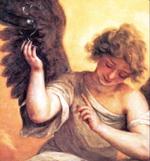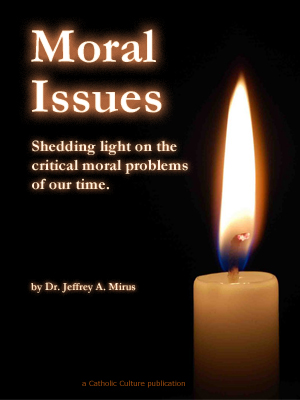Catholic Activity: Explaining the Mass and Sacraments
Mary Newland explains good methods of instilling an understanding of the Mass and the sacraments in young children.
DIRECTIONS
Here, also, is the foundation for the child's love and understanding of the Mass. Plainly, pre-school children can learn easily enough that "we go to Mass to offer sacrifice," but since such forms of sacrifice are strange to us in the Western world, children must be helped to understand that this sacrifice is more significant than the self-denials, "sacrifices," of candy and pennies during Lent.
An introduction to this form of sacrifice comes in Genesis, immediately after Adam and Eve are expelled from the Garden, with the oft told story of Cain and Abel. Here Cain and Abel are compelled by conscience to offer sacrifice, Abel by a good conscience which loves God and is sorry for sin, Cain by an evil one which sees it is expedient that he go through the motions. Abel's offering is a sign of his love, his indebtedness to God, his sorrow for his sins, and God is pleased. Lambs and calves do not pay for sins but God is pleased that Abel has tried. Cain, on the other hand, does not fool God with his insincerity. His offering is not accepted and God asks sharply: "Why do you have a scowl on your face? If your offering were sincere, would it not be acceptable?"
Here is the first lesson in sacrifice for little ones. Ultimately, it does give meaning to the little Lenten offerings, but it must be understood also in its original context: our relation as creatures to our Creator. With this story, parents can teach children that the kind of sacrifice offered at Mass is a sign of the offerer's life, his love, his need, his sorrow, his gratitude. From three or four years on, children may be reminded (in whispers) at Mass to "offer the bread and wine with Father, and offer yourself, dear." Learning that after the Consecration Jesus is present, they may be reminded, "Now you have Jesus for your gift to give — offer Him to God the Father."
This story also teaches them the importance of a right interior disposition. For example: how important is our preparation before Mass and at the foot of the altar. Confiteors, acts of contrition of all kinds, must be sincere.
Abel's story is followed in Holy Scripture by other sacrifice stories: Noe and his sacrifice of thanksgiving after the safe journey in the ark; Melchisedech and his sacrifice of bread and wine after Abraham's victory; Abraham and Isaac and God's command to sacrifice; Moses and the sacrifice that is a sign of our ransom from sin. Each story illumines the final totally effective sacrifice of Christ on the Cross, made present again in the Mass.
Footnotes and the dictionary sections in the family's Bible, the notes in the family's missals, as well as other readings, help parents grasp the significance of the various sacrifice stories and explain them to their children so that "going to offer sacrifice" can become meaningful to the very young. Children are not able to manage all the parts of the Mass for a long time, but they can understand why they go to Mass and how to take part in their way. Mothers may enhance the stories of sacrifice by encouraging creative projects with crayons, colored papers, scissors, play with dolls, many things. These activities need be neither elaborate nor brilliantly executed to be effective. Children take them with them lasting impressions from such adventures, even though to the adult eye they seem only to have made a mess.
Now, after the Redemption, we have a God who has been a man. Now God has lived in our world, suffered in it as we do—and as we make one another suffer — and left us in His Church all that we need to heal the wound we inherited from Adam, in His teaching all that we need to know to live in a fallen world like God. Our mother, the Church, teaches as all mothers teach, with words, signs, and symbols. Not only does she give our children divine life in the sacraments, but also the visible signs we need to teach our children about the divine life they possess.
For example, the sin of Adam is washed off our souls by the water and words of baptism. A mother can meditate most fruitfully on this, alone and later with her children, as she washes anything — children, dishes, clothes, floors, windows. Penance, too, is a cleansing as well as a healing. The saints have used the washing of windows as an example of how the light of grace shines into the soul after the grime of sins is removed. Our Lord called Himself a physician who comes to heal souls, making them well through the sacrament of penance after they have been sick with sin. These examples make excellent sense to preschoolers.
To help us grow strong in the life of grace, our souls are fed the food which is God Himself, the Holy Eucharist. Adam could not eat God. Even angels cannot eat God. But we can — and must, or we will die. As one's body must have food so it will not die, so one's soul must have food so it will not die. Both father and mother can meditate on this as they work, then teach it to their children. The father, as he labors daily to earn his family's food, and the mother, as she prepares and serves the food for her family's bodies, are types of Christ, who labored on the Cross that His bride, the Church, might feed her children's souls the food that is His body. Out of such meditations comes the material for the parents' teaching. Certainly the doctrines are not new, but often heard in the Gospels at Mass, in sermons, in the confessional. Perhaps it is a new idea that this be taught long before First Communion time, but it is the best possible preparation, together with the frequent encouragement to make spiritual communions. The cost for the parents? A certain disciplining of one's thoughts for a while each day, curbing one's use of kitchen and car radio, time-wasting conversations, telephonings, aimless reading. For parents who pray, attend Mass and the sacraments regularly, the habit of meditation is not too difficult to acquire.
If parents hesitate to teach such great truths in such simple ways, they have but to read in the Gospels how Jesus taught, then follow His example. He, too, takes the little children into His arms. He does not object to the simplicity of their faith, nor to the simplicity with which they must be taught. Indeed, He is "indignant" when the apostles suggest they be sent away.
He gives the family its basic rule of life when He explains the last judgment to the apostles. The good will be saved, He says, because "when I was hungry, you gave me to eat, when I was thirsty, you gave me to drink, when I was naked, you clothed me. . . ." The damned will be lost because "you did not give me to eat, or to drink, or clothe me." He is saying that we must see Christ in one another. But how is it possible to teach this to children, and when?
Activity Source: Teaching Religion at Home by Mary Reed Newland, B. Herder Book Co., St. Louis, Missouri, 1963






